Choosing the Right Fishing Line: Fluorocarbon vs Braid vs Monofilament
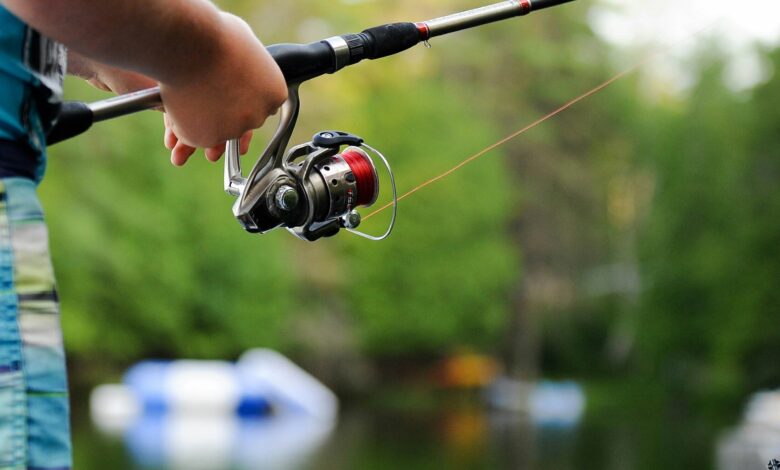
When it comes to fishing, one of the most critical decisions you’ll make is choosing the right type of fishing line. It’s a choice that can make or break your fishing experience, affecting everything from your casting distance to your ability to detect bites.
With so many options out there, it can be tough to know where to start. But don’t worry, we’ve got you covered! In this article, we’ll break down the three main types of fishing line – monofilament, braided, and fluorocarbon – and help you figure out which one is best for your needs.
Three Main Types of Fishing Line Broken Down
Before we dive into the specifics of each type of fishing line, let’s take a quick look at the three main categories:
- Monofilament: This is the most common type of fishing line and has been around for decades. It’s made from a single strand of nylon and is known for its stretchiness and affordability.
- Braided: Braided line is made from multiple strands of high-strength fibers that are woven together. It’s incredibly strong, has virtually no stretch, and is highly sensitive.
- Fluorocarbon: Fluorocarbon is a relatively new type of fishing line that’s made from a single strand of polyvinylidene fluoride (PVDF). It’s nearly invisible underwater and has very low stretch.
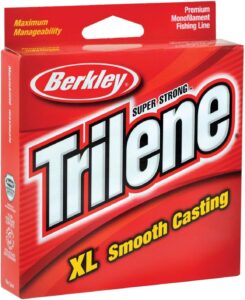
Monofilament
Let’s start with the old reliable: monofilament. Mono, as it’s often called, has been the go-to choice for anglers for generations. It’s affordable, easy to use, and versatile enough to handle a wide range of fishing situations.
One of the biggest advantages of monofilament is its stretchiness. This can be a double-edged sword, but in general, it’s a good thing. The stretch helps to cushion the blow when a fish strikes, reducing the risk of the hook tearing out of the fish’s mouth.
It also helps to absorb some of the shock when you’re fighting a big fish, which can be a real lifesaver if you’re using light tackle.
As you can see in the image above, Berkley Trilene is one of the most common and popular types of monofilament fishing line.
Another advantage of monofilament is its buoyancy. It floats on the surface of the water, which makes it a great choice for topwater lures and other presentations where you want your line to stay on top.
Think of mono as your daily driver. Whether you’re fishing early spring bass or late fall walleye, this line is always reliable.
On the downside, monofilament is not as strong or abrasion-resistant as other types of line. It can also be more visible underwater, which can spook wary fish in clear water conditions.
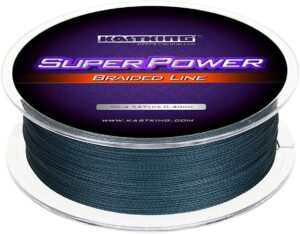
Braided
If you’re looking for pure strength and sensitivity, it’s hard to beat braided line. Braid is made from multiple strands of high-strength fibers that are woven together to create an incredibly strong, thin line.
One of the biggest advantages of braided line is its lack of stretch. This makes it incredibly sensitive, allowing you to feel even the lightest bites. It also gives you better hook-setting power, since there’s no stretch to absorb the energy of your hookset.
Another advantage of braided line is its durability. It’s highly resistant to abrasion and can withstand a lot of punishment from rough underwater terrain or toothy fish.
When comparing fluorocarbon vs braid, these are two things that these lines have in common is abrasion resistance. The KastKing braided in the image above is a popular option.
The downside of braided line is that it can be visible underwater, especially in clear water conditions. It can also be more difficult to handle than monofilament, since it has a tendency to dig into itself on the spool.
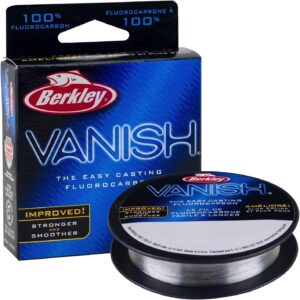
Fluorocarbon
Fluorocarbon is the new kid on the block when it comes to fishing line, but it’s quickly become a favorite among serious anglers.
It’s made from a single strand of PVDF, which is a type of plastic that has a refractive index similar to water. This means that it’s nearly invisible underwater, making it a great choice for spooky fish in clear water.
Like braided line, fluorocarbon has very low stretch. This makes it highly sensitive and gives you excellent hook-setting power. It’s also highly abrasion-resistant and can withstand a lot of punishment from rough underwater terrain.
One downside of fluorocarbon is that it can be stiff and difficult to handle, especially in cold weather. It’s also more expensive than monofilament, which can be a turnoff for some anglers.
Fishing Line Test: Understanding It
When you’re shopping for fishing line, one of the first things you’ll notice is the “test” or “lb test” rating. This refers to the breaking strength of the line, measured in pounds. For example, a 10 lb test line should be able to hold 10 pounds of weight before breaking (in theory).
The test rating is important because it gives you an idea of how strong the line is and what size fish it can handle.
In general, you’ll want to use a heavier test line for larger fish and a lighter test line for smaller fish. But there are other factors to consider as well, such as the type of fishing you’re doing and the conditions you’ll be fishing in.
How Do I Choose the Right Weight Fishing Line?
Choosing the right test line depends on a few factors. First, consider the size of the fish you’re targeting. If you’re going after big game fish like marlin or tuna, you’ll need a heavy test line in the 50-130 lb range. For smaller fish like bass or trout, a lighter test line in the 4-12 lb range is usually sufficient.
You’ll also want to consider the type of fishing you’re doing. If you’re fishing in heavy cover or around structure, you may want to use a heavier test line to help prevent breakoffs. If you’re fishing in open water or using finesse techniques, a lighter test line may be more appropriate.
Finally, consider the conditions you’ll be fishing in. If you’re fishing in clear water, you may want to use a lighter test line to reduce visibility. If you’re fishing in stained or murky water, visibility is less of a concern and you can use a heavier test line.
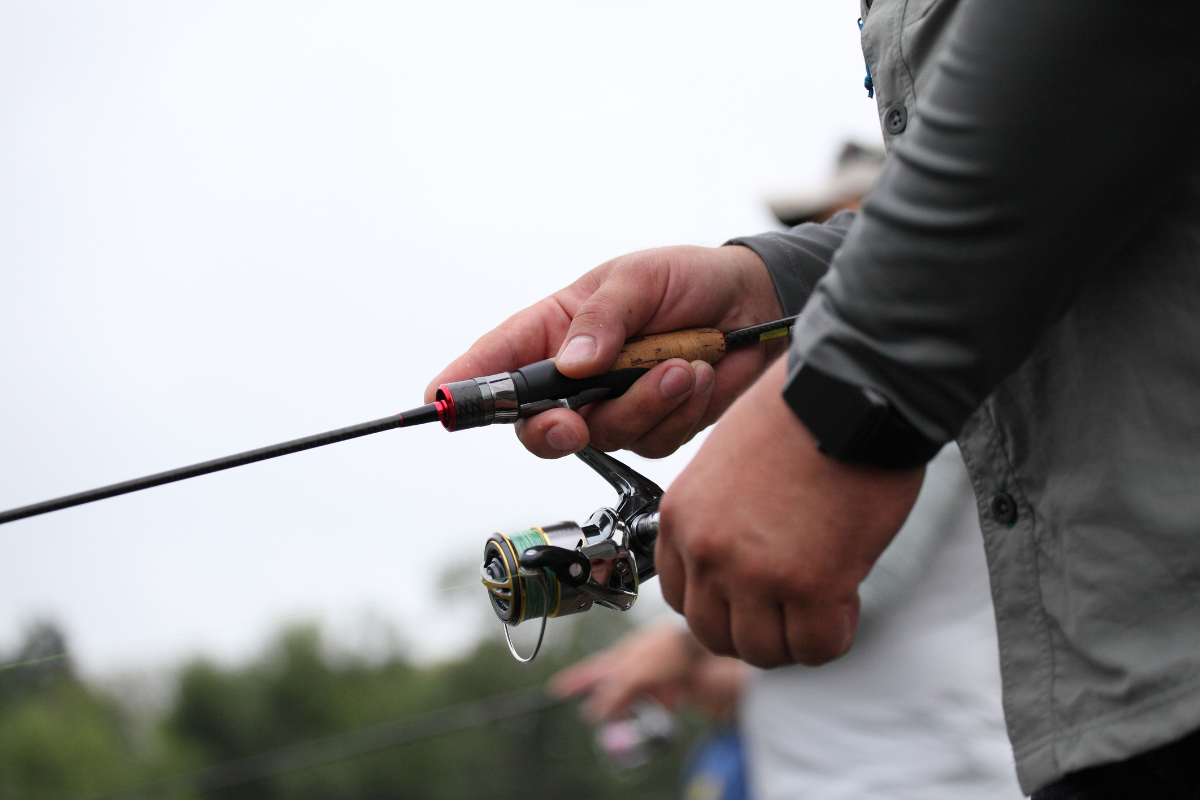
What is the Easiest Fishing Line to Use?
For beginners, monofilament is often the easiest type of fishing line to use. It’s affordable, widely available, and easy to handle. It also has a bit of stretch, which can help cushion the blow when a fish strikes and reduce the risk of breakoffs.
Braided line can be a bit more challenging to use, especially for beginners. It has a tendency to dig into itself on the spool, which can cause tangles and backlashes. It also requires a bit more finesse when casting, since it has no stretch and can be prone to wind knots.
Fluorocarbon can also be tricky to use, especially in cold weather when it becomes stiff and difficult to handle. It also requires a bit more attention when tying knots, since it can be slippery and prone to slipping.
How to Choose a Color For Your Fishing Line?
The color of your fishing line can also play a role in your success on the water. In general, you’ll want to choose a line color that blends in with your surroundings and doesn’t spook the fish.
For clear water conditions, a clear or light blue line is often the best choice. These colors are less visible underwater and won’t spook wary fish.
In stained or murky water, a high-visibility color like yellow or green can be a good choice. These colors are easier to see above the water, which can help you detect bites and monitor your line.
For low-light conditions or night fishing, a fluorescent or glow-in-the-dark line can be a good choice. These lines are easier to see in low light and can help you keep track of your line and detect bites.
What Type of Fishing Line is Best for Leaders?
When it comes to leaders, fluorocarbon is often the best choice. Its low visibility and high abrasion resistance make it ideal for use as a leader material. It also has very low stretch, which can help with hook-setting and sensitivity.
Monofilament can also be used as a leader material, especially in situations where a bit of stretch is desirable. It’s also more affordable than fluorocarbon, which can be a consideration for some anglers.
Braided line is not typically used as a leader material, since it’s highly visible and can be damaging to the fish’s mouth and gills.
Final Thoughts
Choosing the right fishing line is a critical decision that can have a big impact on your success on the water. By understanding the different types of line available and their strengths and weaknesses, you can make an informed decision that will help you catch more fish and have more fun on the water.
Whether you choose monofilament, braided, or fluorocarbon, the key is to match your line to your fishing situation and the conditions you’ll be fishing in. With a little bit of knowledge and experimentation, you’ll be able to find the perfect line for your needs and take your fishing to the next level.


